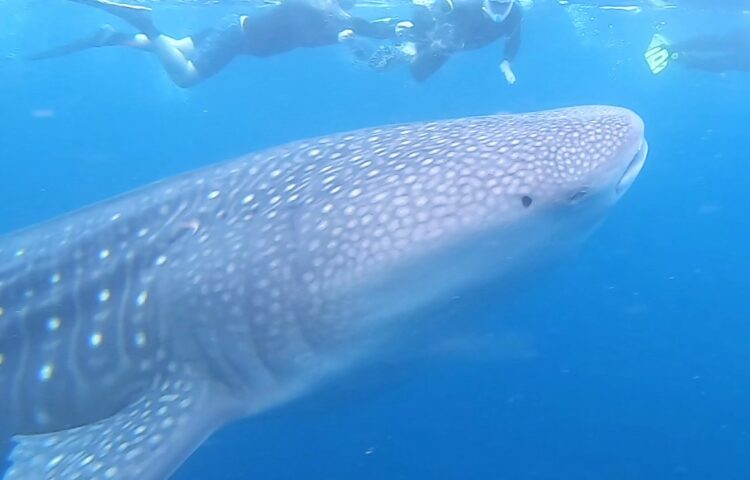Whale sharks are amazing creatures. With their size of almost 12m long and their calmed speed and manners, it is trully and experience to observe them and try to keep up with them. They can be found in several places, among them the Philippines. Some places are more considerate than others, and we should aim to swimming with whale sharks responsibly and to not cause harm to the greatest fish in the sea.
In this post you will find information on what it means swimming with whale sharks responsibly as well as the best spots in the Philippines to do so, and also the worst ones. There is also a detailed account on our experience at Sogod, and a discussion on the good and not so good practices there. And lastly, a section on how to arrive to the main places in the Philippines where you can have this experience.
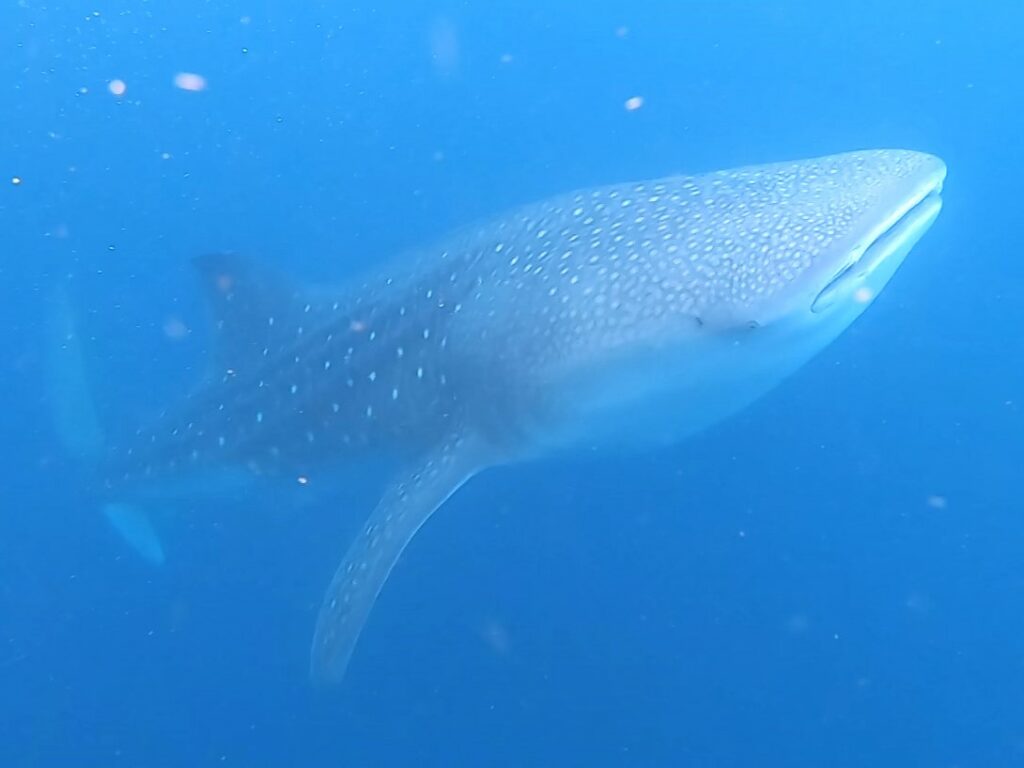
Also, if you are just starting to plan your visit to the Philippines and want some generic information, check my other post ‘Visiting Philippines: everything you need to organise your trip‘. There you will find a guide on how to start organising your trip there. From how to decide on the activities you want to do when visiting the Philippines, how to move from one place to the other or when to book everything. Also, there is information about visas, health, climate, the backpack you’ll need, recommendations money-wise and how to get a SIM card.
Contents
Introduction
Whale sharks are the biggest fish in the sea. They can exceed 10-12m long and weigh up to 22 tons. Despite that, their swimming speed is of three miles per hour, so it is not that difficult to keep up with them.
The skin of these giant gentle creatures is spotted with thousands of dots. Their meter-wide mouth is also one of their more characteristic traits, almost always wide open to sieve plankton and small fish. Whale sharks cannot bite their food -nor do they bite humans-, however despite of that they have around 3,000 tiny teeth, maybe a leftover from a previous ancestor.
Traditionally, whale sharks have been fished for their skin, liver oil, fins or meat, having caused its population to decline drastically. In 2016, this species went from vulnerable to endangered. Only around 10% of whale sharks survive to adulthood, but then they can live up to 70 to 100 years. 1,950 of them swim in the archipelago of the Philippines.
In the Philippines, whale sharks are known as buttading and are protected there since 1998. They are so esteemed that they are featured in the 100 pesos bill.

Swimming with whale sharks responsibly
Despite whale sharks being both an endangered and protected species in the Philippines, the money that comes from tourists that want to interact with them is hard to resist. In many places in this archipelago (and I’m sure that in several other countries as well), whale sharks are fed. This serves two purposes: on the one hand, if they don’t need to migrate to get their food they stay in the place all year round, and therefore tourists can pay for the tour regardless of the month, not only when they are migrating; and on the other hand, they approach boats and interactions with tourists are very close.
This seems so convenient for our experience as tourists but is in fact so wrong. It is our responsibility to ensure that when we travel, we do not have a negative impact in the places (and people, and animals) that we visit.
Where not to swim with whale sharks
The most popular and easy place to swim with whale sharks is Oslob, in the island of Cebu (and Panglao by association, as it is located very close). However, there they use whale sharks to attract tourism with little to no respect for this giant’s wellbeing.

Whale sharks are fed in Oslob, which means that they do not migrate anymore and thus their natural habits are disrupted. They also associate boats with food, so they are no longer scared to approach them, which very often results in harm such as being nicked by the boat’s propellers. There is a study published in October 2020 (https://onlinelibrary.wiley.com/doi/10.1002/aqc.3437) by researchers at the LaMaVe Institute that found that 95% of Oslob’s whale sharks have scars attributable to tourism (https://www.lamave.org/news/oslob-whale-sharks-scar-injury).
During our time in the Philippines, we were told by a tourist that had been there that there is a sign in Oslob literally asking not to ride the whale shark. It really broke our hearts that there is the need to put that in writing.
It is true that if you do not have that much time, Oslob and Panglao are the easiest spots where you can swim with whale sharks, as the alternatives are further and a little more difficult to reach than the island of Cebu with its international airport. However I encourage you to channel your empathy and responsibility and to not promote a type of tourism that is harmful for animals and for the environment. Our right for wonder as tourists is nothing compared to the right of wellbeing for whale sharks.

If you want to read a little more about this topic, check this National Geographic article: https://www.nationalgeographic.com/animals/article/whale-sharks-tourism-philippines-benefit-harm-news
Where to swim with whale sharks
The two most popular places for swimming with whale sharks responsibly are Donsol and Sogod (Leyte).
Donsol is the pioneer in ecotourism in the Philippines and rules to not disturb whale sharks are strictly observed. However, conditions at sea can be bad and then the trip would be cancelled, and the spot can get a little crowded in high season.
Sogod is a little less popular which means less crowded, and also chances of sighting are slightly better than in Donsol, specially from December to May. On the other hand, Sogod is more expensive than Donsol.
At neither place is sighting of the whale sharks guaranteed.
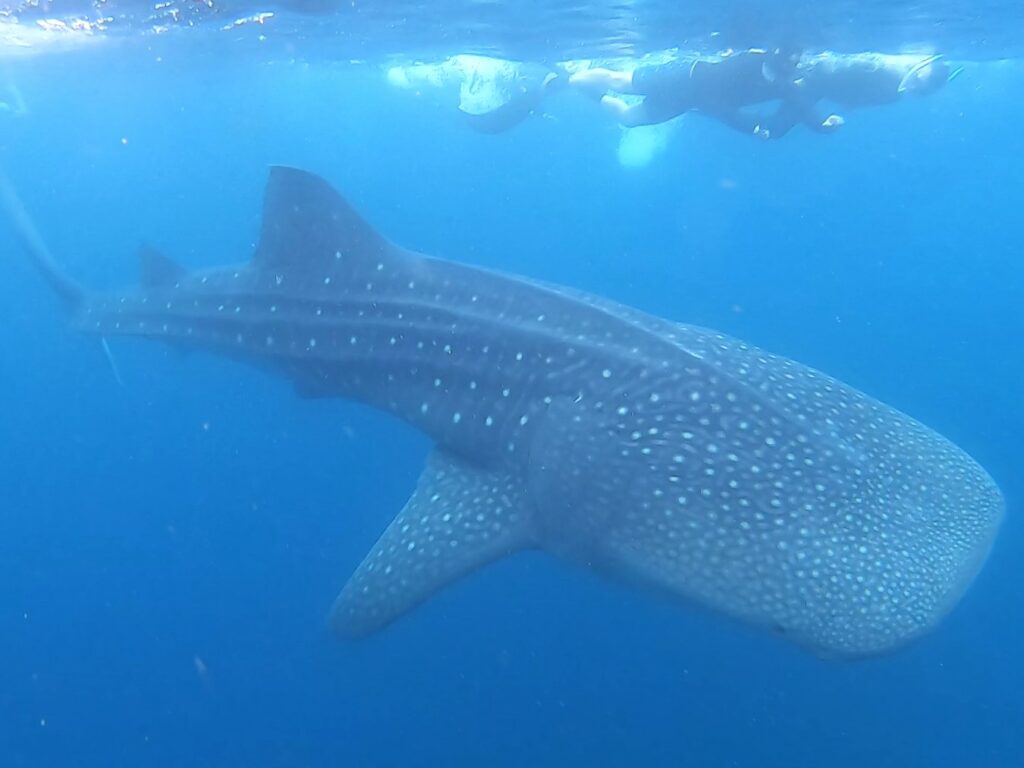
We decided to go to Sogod because chances of sighting were higher and also because you could scuba dive in the surroundings. Having had this experience, I am not sure I would say that Sogod is 100% respectfull with whale sharks. There is a specific section a little below in this post that provides details about our experience.
When in the year you can find them
Whale sharks are migrating through the Philippines from November to May, which is when you can spot them. They stop in Sogod or Donsol to feed on the plankton-rich waters. This is not the case in Oslob, as they are fed there they do not feel they need to leave and therefore are around all year round.
How to swim with whale sharks
There are several safety guides and considerations to respect the wellbeing of the animal that you have to follow when swimming with whale sharks responsibly. These are basically the following ones:
- Only one boat of tourists is allowed per whale shark, so that they don’t have a lot of noise and people around. Also, only six tourists (plus the guide) per whale shark. Interactions should last a maximmum of 30 minutes.
- When entering the water, try not to splash. It can disturb whale sharks and, also, they could change their path.
- For safety reasons for tourists, you should not obstruct the path of the whale shark and should keep a distance of 3 meters from the head of the whale shark and 4 meters from its tail. This is still so close to them! Of course, touching them is absolutely forbidden.
- Do not use flash photography. In fact, my recommendation is to record a video from which you can later extract the best frames as pictures. Selfie sticks are also a hazard.
- It should go without saying, but there it goes: do not feed the whale shark. Although this seems a responsibility for the tour agencies more than for tourists.
- Scuba diving is not allowed as the bubles and clinks from scuba diving tend to scare whale sharks. The alternative is to snorkel with them, which is far less intrusive.
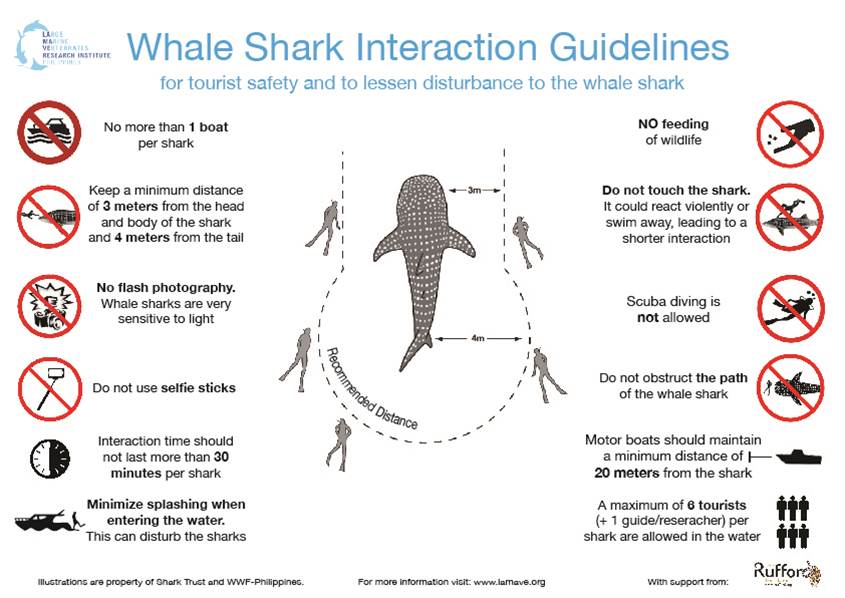
Our experience swimming with whale sharks responsibly in Sogod
Sogod is a bay in the south of the island of Leyte, so there are plenty of towns where you can stay at and take one of the trips to see the whale shark. It doesn’t matter where you stay exactly, as the boat will pick you up from your hotel and navigate to the spot where whale sharks cross during their migration.
One of the most popular towns to stay at is Padre Burgos, mainly because it is also the main diving town in Leyte, still relatively unknown. But there are really a lot of options. This is where we stayed, as we intended to spend a day scuba diving and another in the whale shark tour. In Padre Burgos there is a famous night dive, and on some day dives you can occasionally see hammerhead sharks.
Spoiler: it didn’t go as planned.
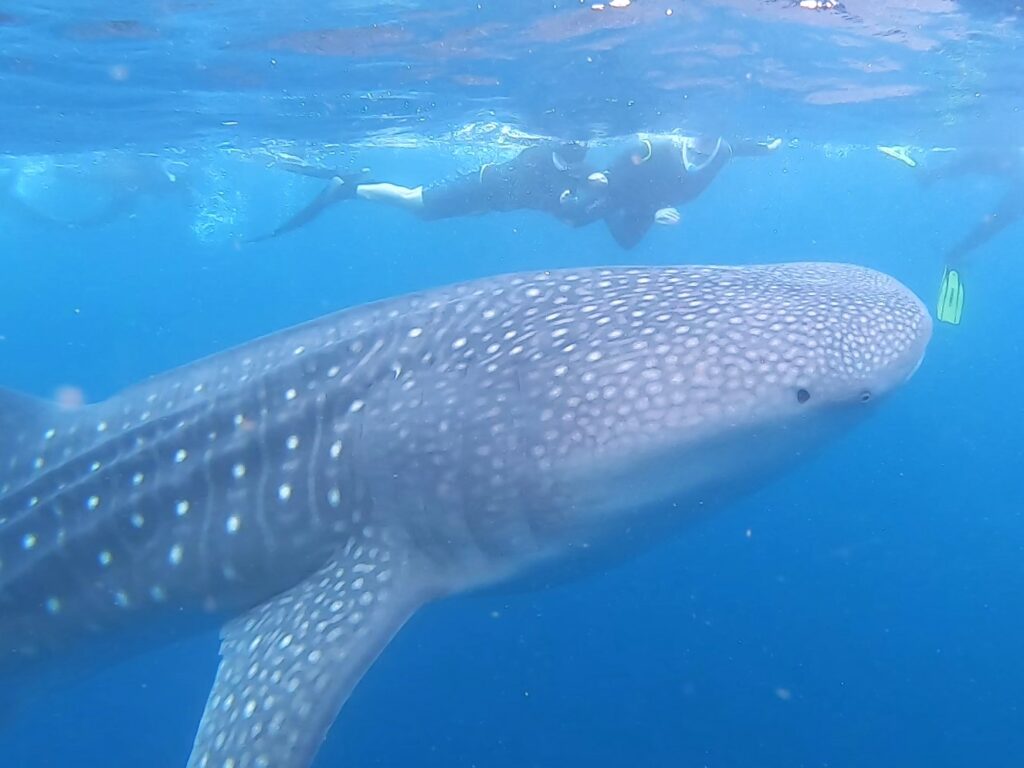
Arriving to Padre Burgos
There is a whole section below on how to arrive to the Sogod Bay and Padre Burgos from different places in the Philippines. However, I wanted to explain our experience in case you can use it to try to organise it better.
Our plan
We had planned to arrive to Sogod from Coron, so we booked a flight to Cebú and intended to take a fast ferry from there to Ormoc (Leyte). From the port you arrive to Padre Burgos by bus. Our first day there was booked for scuba diving and our second for the whale shark tour. So it should have looked like this:
- Day 1: transport from Coron to Padre Burgos.
- Day 2: scuba dive in Padre Burgos.
- Day 3: swimming with whale sharks responsibly.
- Day 4: leaving Padre Burgos.
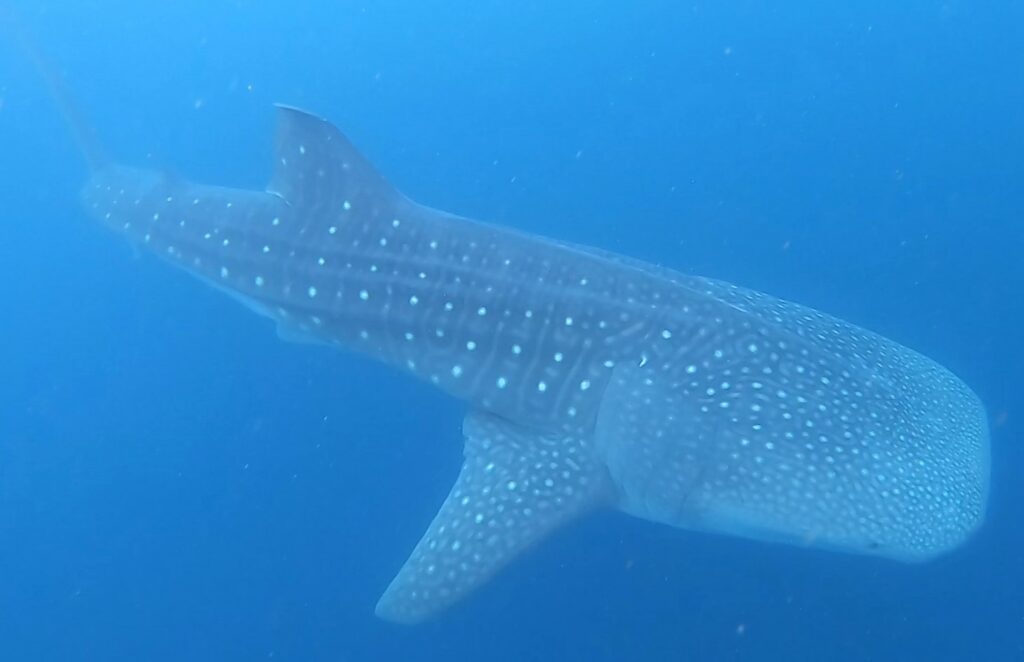
What really happened
Instead, our flight from Coron to Cebu was delayed from 9am to 4pm. We contacted our resort at Padre Burgos and told them we would arrive and leave one day later, and we would scuba dive after the tour. We couldn’t change the day of the tour as they were only having them every four days or so.
Then, our delayed flight was cancelled minutes before departure when we were of course already at the airport. We spent an additional night in Coron and arrived the next day to Cebú at 5pm, when the fast ferries had already left for the day. We took a regular one and it was so uncomfortable as aircon was set at 16°C and we were freezing. On top of that, I had had a mango shake that destroyed my stomach and I lost consciousness and couldn’t leave the bathroom.

Well, we arrived to Leyte and my husband hired a taxi to take us directly to our resort (4 hours drive). It cost us 3,500php but I was in no shape to be taking buses and trycicles. Also, it was 2am in the morning and our whale shark tour left at 8am. We arrived to our resort, rested for an hour and took the tour (which is explained in the next section). We spent the next day in the hotel, still a little sick and definitely unable to scuba dive, and left the following day. So overall it looked like this:
- Day 1: extra day in Coron.
- Day 2: transport from Coron to Padre Burgos.
- Day 3: swimming with whale sharks responsibly.
- Day 4: recovering in hotel.
- Day 5: leaving Padre Burgos.
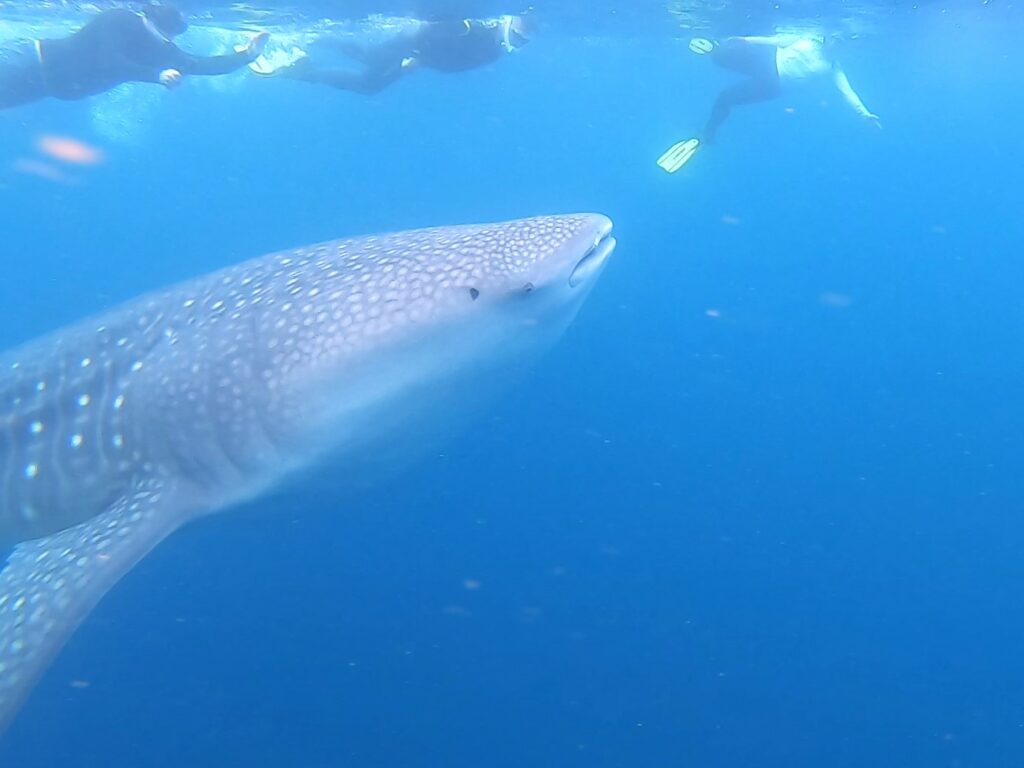
Recommendations
In light of these misadventures I have some recommendations for you to minimise the chances of loosing your tour for swimming with whale sharks responsibly:
- Be flexible! If you have a short time in the Philipines and you cannot be flexible on schedule, at least have a flexible mentality to make it easier for you if plans change. It is very likely that transport plans will change.
- Try to be around the area a day or a few before taking the tour. This way if your transport gets delayed, you will still be able to do the activity.
- Know all the alternative means of transport to arrive to your destination, just in case you need to rearrange everything.
- Do not have mango shakes! Haha or at least check the cleanliness of where you have them.
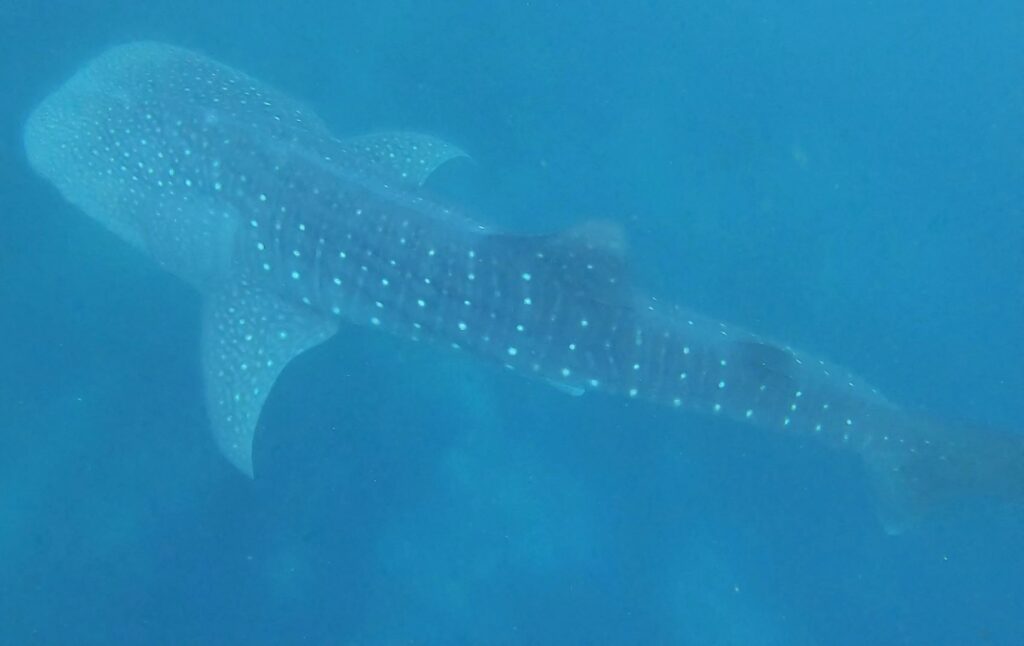
The tour: swimming with whale sharks responsibly
We stayed in Peter’s Divers Resort and took the whale shark tour with them. In their website (https://www.petersdiveresortph.com/dive-center/dive-rates/) you can check the updated prices. We were very comfortable and they helped us a lot and took care of us, even driving my husband to the pharmacy to buy medicine for me.
Tours every three our four days, so you need to organise your schedule. Considering that most ferries are not operating daily, this can require a little planning. It was the only thing that we had booked from home and we planned the rest of the islands and activities accordingly.
In the boat
Your boat will pick you up from your resort and then navigate for about two hours to arrive to the bay were whale sharks are feeding. On the way, you will stop to pick up the spotters, which are people on kayaks with snorkeling glasses that look for the whale sharks underwater. They are tied to your boat to move easily, and when the boat stops they spread around.

At some point, you will get a briefing on how to behave.
There are several boats in the bay doing the same activity. In our boat we were like 10-12 tourists and had two or three guides with us. It is difficult to know as some of the staff goes to the water when a whale shark is seen, but I don’t know if all of them are guides.
You are always semi-equipped to enter the water fast. And when a whale shark is around… it is honestly chaotic. Guides are encouraging you to get to the water, everyone is in a hurry and it trully feels like there’s a nuclear bomb about to fall upon us and the only safe place is the water.

With the whale sharks
You stay in the water until the whale shark is too far, and this is repeated for every whale shark that is spotted.
Even if whale sharks are slow swimmers (that is, considering their size), it is not that easy to keep up with them. If you want to try, you should be a good strong swimmer. Despite that, the interactions are not fast as whale sharks take their time to peacefully move from one place to another, so they are around for several minutes which is plenty of time to enjoy their company.

We were able to see five or six whale sharks, some of them from a distance and some others emerged from the water right next to us.
By the way, the water in that bay is crowded by tiny jellyfish. Some people knew about that (we didn’t) and wore neoprene suits. But I wouldn’t say it is necessary. You almost don’t feel the sting and it only lasts for twenty minutes or so.
I was personally feeling extremely miserable for the whole tour, but I had not slept, I was sick and spiked a fever after the experience. Anyway, I loved swimming with whale sharks, and everyone else was delighted with the day. I would recommend you to wear a rain cover or light jacket (that can be wet), as the wind is strong in the boat and if it rains (as it did when we went) it can be a little cold.

Is it really responsible?
I cannot answer with a yes or a no. If responible means respecting all the guidelines I explained before, then no. Whale sharks didn’t seem to mind us being there, however I am in no way in the capacity to know if they were disturbed or not. They were not fed, and had no visible scars.
The restrictions of one boat and six tourists per whale shark were not respected. And definitely everyone was splashing when they entered the water.
Does this mean that you should go to Donsol instead of Sogod? I couldn’t know. As you probably know already (or will know once you look for additional details on swimming with whale sharks responsibly), it is hard to find information on this topic. I have only been to Sogod, so I can only explain my experience there, but I can’t compare it with Donsol.

How to arrive
I will not lie, arriving either to Donsol or Sogod for swimming with whale sharks responsibly is not easy and will require some planning. Particularly if you decide to go to Sogod as chances to see whale sharks are a little higher than in Donsol. Also, depending on the itinerary you will be doing and your budget, you will be able to arrange it easier or shorter, for example if you can arrive to Sogod through Manila by plane.
In this very detailed section you will find all the information you will need on how to arrive to the precious whale sharks, particularly if you plan to see them at Sogod (it is where we went).
Also, you should know that transport in the Philippines would deserve a single blog on its own. In my opinion, it is one of the most difficult things to organise and one of the most difficult countries to move around. Especially if you have a short time in the country, it can feel like you spend forever travelling. So, I have prepared an independent post with plenty of generic information on transport: ‘Transport in the Philippines: how to go from one place to another and survive the process‘. Check it to be prepared!
How to arrive to Donsol
From Cebu
There’s a direct flight from Cebu to Legazpi each morning at 5.15h. It lasts 1h15min. On Tuesdays and Thursdays there is a second flight at 15.55h.
From there take a tricycle to the bus shuttle and then a van to Donsol, asking to be dropped at Giddy’s.
To return, there is a flight each day to Cebu at 6.50h and on Tuesdays and Thursdays also at 17.30h.
How to arrive to Sogod
Sogod is located in the South of the Island of Leyte, and it pertains to the region of Eastern Visayas.
The most important ports are Maasin, Bato, Hilongos, Ormoc and Lilo-an. The closest airport is at Tacloban, in the North of the island.

From Cebu
There are five alternative routes from Cebu to Sogod. The first four arriving by ferry and last one by plane.
It is not possible to buy the ferry tickets online, so you will need to be in Cebu with time to buy them there. All shipping lines have offices next to the port, however they all have different schedules so you need to consider their business hours. For example, we were unable to buy tickets for a fast ferry because offices were already closed when we arrived, even if there was one fast ferry leaving that evening.
You could buy the ticket some days in advance if you happen to be at Cebu, although I’m not sure if that’s a good idea if you have connecting flights or other ferries, as they might get cancelled and you would be unable to receive your money back.

Through Ormoc
Ormoc is one of the main ports in Leyte and is very well-connected with Cebu. There are four shipping lines offering this route:
- Roble Shipping: daily ferry at 10pm. It lasts for 5 hours. Rates start at 600php. Check updated schedule and rates here: https://www.robleshipping.com/schedules-rates/.
- Lite Shipping: daily ferry at 11am, 5 hours.
- Oceanjet: fast ferries everyday at 6am, 10.30am, 1.30pm and 5pm. They arrive to Ormoc in 2 hours 40 minutes. Rates start at 1,200php. You can check the updated schedule and rates here: https://www.phbus.com/oceanjet/.
- Supercat: fast ferries everyday at 5.15am, 7.45am, 10.25am, 12 noon, 2.45pm and 5pm. They arrive to Ormoc in 3 hours. You can check the updated schedule here: (http://www.supercatschedule.com/Schedule)

Once at Ormoc, you’ll need to take a bus or van to Sogod or Maasin. They cost about 100-200php and lasts for 3.5 hours. They are generally available from the port, however, if they are not, you can go to Ormoc City Park.
Through Maasin
There is only one ferry operating the route of Cebu to Maasin. The company is Cockalion Shipping and the weekly ferry leaves each Monday at 7pm from Cebu and arrives at 1.30am to Maasin. Fares start at 540php. You can check update schedule and rates here: https://www.cokaliongshipping.com/index.php/about/
From Maasin, you can take a bus or van to take you to your specific final destination. You should check schedules accordingly. Alternatively, you can ask your resort to pick you up from the port (they generally pick up from anywhere in Leyte).
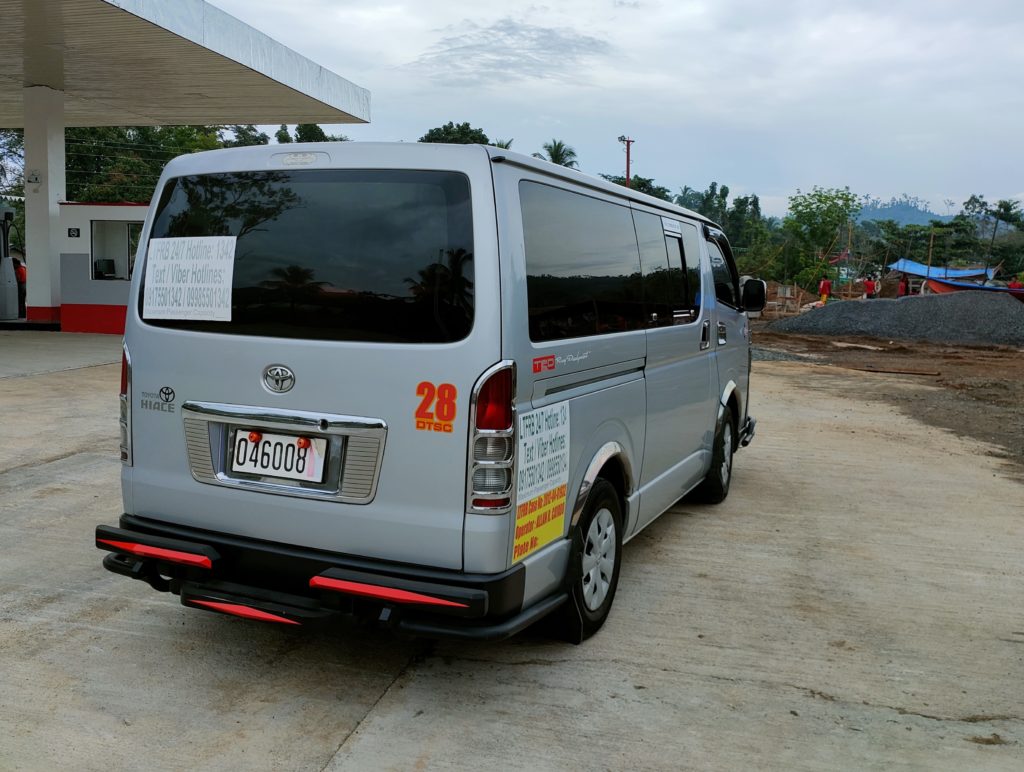
Through Hilongos
There are several companies operating this route, the main ones are Roble Shipping and Gabisan Shipping Lines. The boat trip takes 5 hours with either company.
- Roble shipping: daily boats at 9pm and at 11am on Fridays, Saturdays and Sundays. Rates start at 480php. Check updated schedule and rates here: https://www.robleshipping.com/schedules-rates/.
- Gabisan Shipping Lines: there is not information that is official from the company, but we found that there are several boats each day:
- Daily one at 9pm.
- Wednesdays at 11am.
- Monday, Thursday, Friday, Saturday and Sunday at 2pm and 9pm.
It would be a good idea to check ferry schedules with your resort, just in case.
From 13th December 2022 there’s a new operator covering this line, Seacat by GRAND Ferries. You can check the schedule here: https://m.facebook.com/story.php?story_fbid=2418421768296126&substory_index=0&id=1088163491321967

They are not operating everyday, just Monday, Tuesday, Thursday and Saturday. Departures from Cebu to Hilongos are at 6am and 1pm, and navigation time is 2 hours and a half. Departure from Pier 3. Booking online available at https://booking.barkota.com/search.
There are buses right at the port that can take you to Maasin and other popular destinations. The bus to Maasin lasts for 90 minutes and can cost around 60php.
Through Bato
There are two ferry lines operating this route:
- Medallion Transport: ferries on Monday, Wednesday and Friday at 8.30pm. It lasts 6 hours and costs start at 325php. They can be booked online. Check updated schedule and rates here: https://www.medalliontransportinc.com/shipping/
- Southern Pacific Trans. Corp.: ferries leave each day at 8pm and arrive at 3am. You can contact them through their Facebook page: https://www.facebook.com/profile.php?id=100064161367125
The same buses that leave from Hilongos pass through Bato to Maasin. In this case, the bus drive lasts for one hour.

Through Tacloban
It is more expensive and not faster, but it can provide alternatives in terms of schedule. You can arrive to Tacloban airport from Cebu or Manila.
From the airport, take a tricycle to Central Terminal. There are several vans and buses that can take you to the area of Maasin or Sogod. Vans are faster and last for about 3 – 4 hours.
From Bohol
Ferries to Leyte Island leave from the port of Ubay in Bohol, so you will first need to arrive there. From Tagbilaran you need to head to DAO Terminal and take a bus. They leave every 20 minutes from 5am to 8pm, cost 160php per person and take 3.5 hours to get there.
Once at the port of Ubay, you can arrive to Leyte either at the Port of Hilongos or at the port of Bato. They all take approximately 2 hours. Your options are:
- Medallion Transport: daily ferry at 2pm. Arrive to Bato. Check schedule here: https://www.medalliontransportinc.com/shipping/
- Leopard Lines: daily departures at 9am. Arrive to Hilongos.
- Mama Mary Chloe Fast Ferry: leave daily at 10am. Arrive to Bato. Check schedule here: https://2gopromofares.com/nno-shipping-lines-nn-mama-mary-chloe-ubay-bohol-to-bato-trip-schedules/
Either from Bato or Hilongos, you’ll need to take a bus to Maasin and from there a van to Padre Burgos. It will overall take you 1.5 – 2 hours. If you have a different final destination, you might need to head to Sogod instead of Maasin from the port.

From Siargao
If you start really early, it is possible to arrive from Siargao to Padre Burgos on the same day.
The first step is to take a boat from Siargao to Surigao, in Dapa. Companies like Evaristo and Sons are leaving each day from 4am to 3.30pm. The trip generally costs 300php and lasts for 1.5hours.
Once at Eva Macapagal Passenger Terminal in Surigao you need to arrive to the port of Lipata. You’ll need to walk or take a tricycle to Luneta Park, and from there take a Jeepney to the port (the drive is 8km).
From Lipata Port you’ll need to take a boat to Lilo-an with Fastcat at 12am, 6am, 12pm or 6pm (check updated schedules here: https://www.fastcat.com.ph/schedules/#1521184793782-47cd4105-4365). They last for 3 hours and price starts at 140php.
Lastly, from Lilo-an you can take either a bus or a van leaving to Sogod or Maasin. You should ask the driver if they stop where you need to, because there are plenty of options but not all buses will. The drive takes up to 4 – 5 hours depending on your final destination.

From Malapascua (through Cebu)
First you need to go from the island of Malapascua to Maya Port at the island of Cebu. There are public bangkas leaving every 30 minutes from 6.30am to 4.30pm, 45min trip for 100php. There are also private bangkas, with far more expensive fares.
Then, from Maya Port to Cebu: you will arrive at Cebu Bus North Terminal and you have the option of the bus or the van to get there.
- Buses are available from 1am to 6pm, and fares start at 170php. The ones with no air conditioned take 4 hours because they don’t stop, the ones with aircon can take more than 6 hours because they stop along the way.
- Vans also take 4 hours and cost 200php, although there is little leg room so if you are tall or travel with a lot of luggage maybe it is not the best option for you.
Both bus or van leave from the port and arrive to Cebu North Terminal.
Once at Cebu, follow the steps previously described.

From Malapascua (through Kalanggaman)
This can be a little tricky because there are no official ferry lines operating this route and you’ll need to negotiate transport with companies offering private tours. Besides the negotiation part, which can make for a more expensive boat ride, if there are no tourists doing this daily trip, you’ll have no transport available.
I would only recommend you to explore this route if you want to explore or sleep in Kalanggaman. If this is not important for you, I think that arriving to Padre Burgos from Malapascua is easier through Cebu. Also, by stepping foot in Kalanggaman, you’ll need to pay the conservation fee of 500php, which makes little sense if you are not going to stick around.

Anyway, these are the steps:
- Negotiate your transfer to Kalanggaman with day tour operators. The day tour costs 700php, so maybe a good rate can be 400php. Tours normally leave at 9am and the trip lasts 2 hours.
- Negotiate your transfer to Palompon (Island of Leyte): you will need to wait until day tour trips leave, normally around 3 or 4pm. A boat for 15 people costs 3,000php, so the price will vary depending on the number of people you are. The trip lasts for 45 minutes.
- Take a bus or van from Palompon to Ormoc. Van is faster, it costs 150php and takes 90 minutes.
- Take a bus or van from Ormoc to Maasin or Sogod. Again, vans are faster. The drive lasts for about 3.5hours.
From Manila
You can arrive through the airport of Cebu or the airport of Tacloban (in the same island of Leyte).
From the airport, take a tricycle to Central Terminal. There are several vans and buses that can take you to the area of Maasin or Sogod. Vans are faster and last for about 3 – 4 hours.

Was this post on swimming with whale sharks responsibly useful for you? Please let me know and feel free to ask any question in the comments section! You can also support my work and Buy Me A Coffe. I will be immensely happy 🙂
